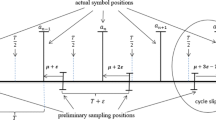Abstract
Due to constraints of cost and size for mobile devices, a digital self-synchronous OFDM receiver is preferable in mobile applications since it only requires economical crystal oscillators plus free-running analog front-end circuits. However, there are more stringent requirements for clock timing recovery tasks in such a self-synchronous receiver. This paper presents an efficient and robust clock timing recovery scheme for the digital self-synchronous OFDM receiver. It is based on the canonical Gardner structure, but new techniques are devised for performance improvement. A joint iterative estimation algorithm is used for error detection, which can not only improve the detection precision, but also maintain the loop’s dynamic performance. A direct control method based on a simple dynamic delay technique instead of the numerical-controlled oscillator mechanism is adopted to smoothly adjust the timing recovery by adaptively performing asynchronous resampling on the discrete sequence of the received signal. Theoretical analysis and numerical simulation results are also presented to verify the effectiveness of the proposed clock timing recovery scheme and conduct performance analysis and evaluation.









Similar content being viewed by others
References
Fechtel, S. A. (2000). OFDM carrier and sampling frequency synchronization and its performance on stationary and mobile channels. IEEE Transactions on Consumer Electronics, 46(3), 438–441.
Ai, B., Shen, Y., Zhong, Z. D., & Zhang, B. H. (2011). Enhanced sampling clock offset correction based on time domain estimation scheme. IEEE Transactions on Consumer Electronics, 57(2), 696–704.
Wu, N., Wang, H., & Kang, J. (2011). Performance analysis of code-aided symbol timing recovery on AWGN channels. IEEE Transactions on Communications, 59(7), 1975–1984.
Kim, D.-H., Kang, K.-M., & Lee, C. (2011). A multi-band OFDM ultra-wideband SoC in 90 nm CMOS technology. IEEE Transactions on Consumer Electronics, 57(3), 1064–1070.
Jose, R., Ambat, S. K., & Hari, K. V. S. (2013). Low complexity joint estimation of synchronization impairments in sparse channel for MIMO-OFDM system. AEU-International Journal of Electronics and Communications, 68(2), 151–157.
Lee, H., & Lee, J. (2011). Joint clock and frequency synchronization for OFDM-based cellular systems. IEEE Signal Processing Letters, 18(12), 757–760.
Chen, C., Chen, Y., & Ding, N. (2013). Accurate sampling timing acquisition for baseband OFDM power-line communication in non-Gaussian noise. IEEE Transactions on Communications, 61(4), 1608–1620.
Rabbi, M. F., & Ko, C. C. (2012). Timing jitter tracking for orthogonal frequency division multiple access system in high doppler spread. IET Communications, 6(11), 1438–1446.
Yu, R., Proietti, R., & Yin, S. (2013). 10-Gb/s BM-CDR circuit with synchronous data output for optical networks. IEEE Photonics Technology Letters, 25(5), 508–511.
Gardner, F. M. (1993). Interpolation in digital modems C part I: Fundamentals. IEEE Transactions on Communications, 41(3), 501–507.
Zhou, X., Chen, X., Zhou, W., Fan, Y., Zhu, H., & Li, Z. (2010). All-digital timing recovery and adaptive equalization for 112 Gbit/s POLMUX-NRZ-DQPSK optical coherent receivers. Journal of Optical Communications and Networking, 2(11), 984–990.
Anjum, O., Ahonen, T., & Nurmi, J. (2014). MPSoC based on transport triggered architecture for baseband processing of an LTE receiver. Journal of Systems Architecture, 6(1), 140–149.
Huang, X., Guo, Y. J., & Zhang, J. (2012). Sample rate conversion using B-spline interpolation for OFDM based software defined radios. IEEE Transactions on Communications, 60(8), 2113–2122.
Tsai, P.-Y., Kang, H.-Y., & Chiueh, T.-D. (2005). Joint weighted least-squares estimation of carrier-frequency offset and timing offset for OFDM systems over multipath fading channels. IEEE Transactions on Vehicular Technology, 54(1), 211C223.
Kim, T.-C., Liu, W.-C., Tseng, C.-Y., & Jou, S.-J. (2009). Low complexity synchronization design of an OFDM receiver for DVB-T/H. IEEE Transactions on Consumer Electronics, 55(2), 408–413.
Lin, Y.-T., & Chen, S.-G. (2014). A blind fine synchronization scheme for SC-FDE systems. IEEE Transactions on Communications, 62(1), 293–301.
3GPP TS 36.211. V9.1.0. (2010). Evolved universal terrestrial radio access (E-UTRA); Physical channels and modulation (release 9).
Syllaios, I. L., & Balsara, P. T. (2012). Linear time-variant modeling and analysis of all-digital phase-locked loops. IEEE Transactions on Circuits and Systems I: Regular Papers, 59(11), 2495–2506.
3GPP TS 36.104. V9.1.0. (2010). Evolved universal terrestrial radio access (E-UTRA); Base Station (BS) radio transmission and reception (release 9).
Cvetkovic, Z., Tarokh, V., & Yoon, S. (2013). On frequency offset estimation for OFDM. IEEE Transactions on Wireless Communications, 12(3), 1062–1072.
Acknowledgments
This work was supported in part by the National Natural Science Foundation (NSF) of China (Grant No. 61201177) and in part by the Special Scientific Research Fund of Public Welfare Profession of China (Grant No. 201313009).
Author information
Authors and Affiliations
Corresponding author
Rights and permissions
About this article
Cite this article
Hu, X., Xu, W. & Tian, Y. Robust Clock Timing Recovery for Performance Improvement in Digital Self-Synchronous OFDM Receivers. Wireless Pers Commun 95, 683–701 (2017). https://doi.org/10.1007/s11277-016-3792-9
Published:
Issue Date:
DOI: https://doi.org/10.1007/s11277-016-3792-9




